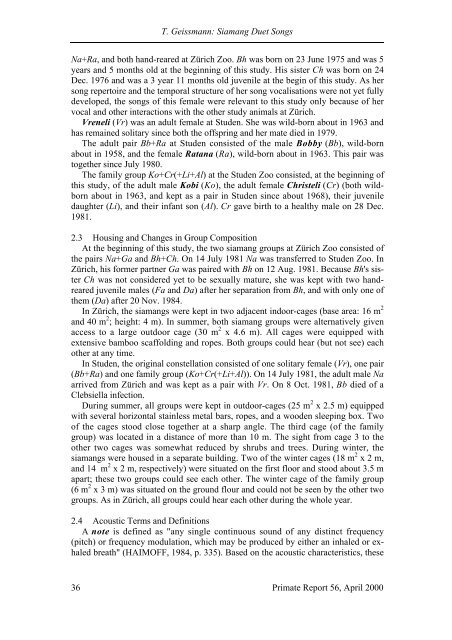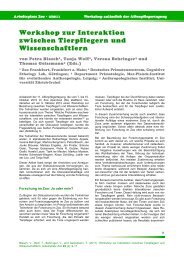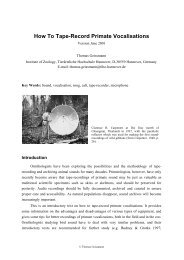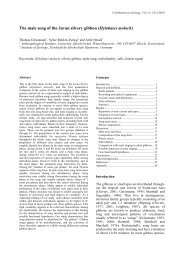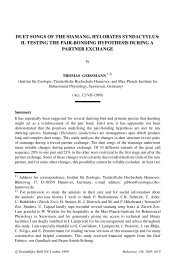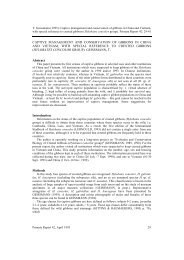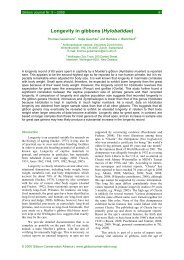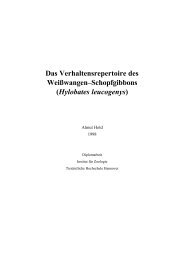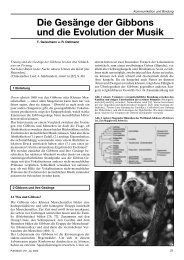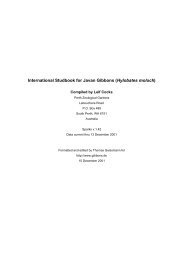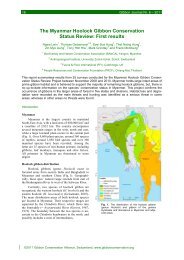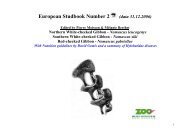Geissmann, T., 2000: Duet songs of the siamang, Hylobates ...
Geissmann, T., 2000: Duet songs of the siamang, Hylobates ...
Geissmann, T., 2000: Duet songs of the siamang, Hylobates ...
Create successful ePaper yourself
Turn your PDF publications into a flip-book with our unique Google optimized e-Paper software.
T. <strong>Geissmann</strong>: Siamang <strong>Duet</strong> Songs<br />
Na+Ra, and both hand-reared at Zürich Zoo. Bh was born on 23 June 1975 and was 5<br />
years and 5 months old at <strong>the</strong> beginning <strong>of</strong> this study. His sister Ch was born on 24<br />
Dec. 1976 and was a 3 year 11 months old juvenile at <strong>the</strong> begin <strong>of</strong> this study. As her<br />
song repertoire and <strong>the</strong> temporal structure <strong>of</strong> her song vocalisations were not yet fully<br />
developed, <strong>the</strong> <strong>songs</strong> <strong>of</strong> this female were relevant to this study only because <strong>of</strong> her<br />
vocal and o<strong>the</strong>r interactions with <strong>the</strong> o<strong>the</strong>r study animals at Zürich.<br />
Vreneli (Vr) was an adult female at Studen. She was wild-born about in 1963 and<br />
has remained solitary since both <strong>the</strong> <strong>of</strong>fspring and her mate died in 1979.<br />
The adult pair Bb+Ra at Studen consisted <strong>of</strong> <strong>the</strong> male Bobby (Bb), wild-born<br />
about in 1958, and <strong>the</strong> female Ratana (Ra), wild-born about in 1963. This pair was<br />
toge<strong>the</strong>r since July 1980.<br />
The family group Ko+Cr(+Li+Al) at <strong>the</strong> Studen Zoo consisted, at <strong>the</strong> beginning <strong>of</strong><br />
this study, <strong>of</strong> <strong>the</strong> adult male Kobi (Ko), <strong>the</strong> adult female Christeli (Cr) (both wildborn<br />
about in 1963, and kept as a pair in Studen since about 1968), <strong>the</strong>ir juvenile<br />
daughter (Li), and <strong>the</strong>ir infant son (Al). Cr gave birth to a healthy male on 28 Dec.<br />
1981.<br />
2.3 Housing and Changes in Group Composition<br />
At <strong>the</strong> beginning <strong>of</strong> this study, <strong>the</strong> two <strong>siamang</strong> groups at Zürich Zoo consisted <strong>of</strong><br />
<strong>the</strong> pairs Na+Ga and Bh+Ch. On 14 July 1981 Na was transferred to Studen Zoo. In<br />
Zürich, his former partner Ga was paired with Bh on 12 Aug. 1981. Because Bh's sister<br />
Ch was not considered yet to be sexually mature, she was kept with two handreared<br />
juvenile males (Fa and Da) after her separation from Bh, and with only one <strong>of</strong><br />
<strong>the</strong>m (Da) after 20 Nov. 1984.<br />
In Zürich, <strong>the</strong> <strong>siamang</strong>s were kept in two adjacent indoor-cages (base area: 16 m 2<br />
and 40 m 2 ; height: 4 m). In summer, both <strong>siamang</strong> groups were alternatively given<br />
access to a large outdoor cage (30 m 2 x 4.6 m). All cages were equipped with<br />
extensive bamboo scaffolding and ropes. Both groups could hear (but not see) each<br />
o<strong>the</strong>r at any time.<br />
In Studen, <strong>the</strong> original constellation consisted <strong>of</strong> one solitary female (Vr), one pair<br />
(Bb+Ra) and one family group (Ko+Cr(+Li+Al)). On 14 July 1981, <strong>the</strong> adult male Na<br />
arrived from Zürich and was kept as a pair with Vr. On 8 Oct. 1981, Bb died <strong>of</strong> a<br />
Clebsiella infection.<br />
During summer, all groups were kept in outdoor-cages (25 m 2 x 2.5 m) equipped<br />
with several horizontal stainless metal bars, ropes, and a wooden sleeping box. Two<br />
<strong>of</strong> <strong>the</strong> cages stood close toge<strong>the</strong>r at a sharp angle. The third cage (<strong>of</strong> <strong>the</strong> family<br />
group) was located in a distance <strong>of</strong> more than 10 m. The sight from cage 3 to <strong>the</strong><br />
o<strong>the</strong>r two cages was somewhat reduced by shrubs and trees. During winter, <strong>the</strong><br />
<strong>siamang</strong>s were housed in a separate building. Two <strong>of</strong> <strong>the</strong> winter cages (18 m 2 x 2 m,<br />
and 14 m 2 x 2 m, respectively) were situated on <strong>the</strong> first floor and stood about 3.5 m<br />
apart; <strong>the</strong>se two groups could see each o<strong>the</strong>r. The winter cage <strong>of</strong> <strong>the</strong> family group<br />
(6 m 2 x 3 m) was situated on <strong>the</strong> ground flour and could not be seen by <strong>the</strong> o<strong>the</strong>r two<br />
groups. As in Zürich, all groups could hear each o<strong>the</strong>r during <strong>the</strong> whole year.<br />
2.4 Acoustic Terms and Definitions<br />
A note is defined as "any single continuous sound <strong>of</strong> any distinct frequency<br />
(pitch) or frequency modulation, which may be produced by ei<strong>the</strong>r an inhaled or exhaled<br />
breath" (HAIMOFF, 1984, p. 335). Based on <strong>the</strong> acoustic characteristics, <strong>the</strong>se<br />
36 Primate Report 56, April <strong>2000</strong>


